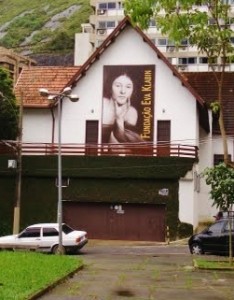
Photo © Michael Sommers.
Whenever I travel to Rio de Janeiro I’m always seduced by the idea of living there. For this reason, I always love visiting homes of people who actually do live there.Recently, I visited two fantastic Rio de Janeiro homes – both of which are located in leafy residential parts of the Zona Sul and both of which are open to the public. Mysteriously, and erroneously, both are also off the radar of most foreign tourists.
The first was a two-story Norman-style villa overlooking the Lagoa Rodrigo das Freitas. Built in 1931, it was one of the first houses built along the shores of this natural lagoon, which has since become one of Rio’s most coveted addresses. In 1952, it became the home of Eva Klabin, the Brazilian-born daughter of Lithuanian Jewish immigrants, Hessel and Fanny Klabin, and her journalist husband, Paul Rappaport.
After the blinding light and scalding afternoon heat, stepping into the cool, wood paneled front room, overflowing with antiquities, was both refreshing and otherworldly.As the founder of Brazil’s first paper and cellulose manufacturer, Hessel Klabin was a rich man who enabled Eva and her younger sister, Ema, to grow up surrounded by the finer things in life. Beginning in the later 1940s, the sisters also began collecting finer things, taking frequent trips to Europe where they went on shopping sprees for paintings, sculptures, furnishings and decorative objects.
When her husband died in 1957, collecting became Eva’s prime passion and occupation. In subsequent years, her collection of classical art grew to over 2,000 objects, becoming one of the largest of its kind in Brazil. In order to house all her acquisitions, she remodeled and expanded the house overlooking the Lagoa where she lived and entertained in grand style, hosting glittering soirees for dignitaries, artists, and intellectuals from all over Brazil and the world. Following Eva’s wishes, upon her death, in 1991, her house was opened to the public as a museum under the auspices of the Eva Klabin Foundation.
You can tour the house Tuesday to Friday, between 2 p.m. and 4:30 p.m., which is what I decided to do on the way home from a hearty hike around the steep slopes of the adjacent Parque da Catacumba. After the blinding light and scalding afternoon heat, stepping into the cool, wood paneled front room, overflowing with antiquities, was both refreshing and otherworldly. I was greeted by a pale young woman who invited me to slip on a pair of Saran-wrap socks (so as not to scratch the beautifully polished parquet floors) before leading me from the Main Hall into the Renaissance Room (Eva named all the rooms, which have been preserved exactly as she lived in them).
On our way to the Chinese Room, the guide and I were joined by a trio of Carioca women, (over)dressed to the nines and with fabulously blown-out hair. As we continued our tour, they proceeded to gush extravagantly over Eva’s knickknacks with squeals of “How precious!”, “How sweet!”, and “I wonder how much that cost?” One of the Cariocas could barely refrain herself from flipping over the Limoges porcelain to check for a price tag. Another clearly wouldn’t have minded making off with a terracotta statue from the Tang Dynasty. As for me, I fell hard for the Ancient Greek lacrymatory, a delicate glass vessel used to catch (and conserve) women’s tears while their men were off waging wars. Talk about a cool – not to mention useful – accessory to have around the house.
Apart from the permanent collection, the Foundation often invites contemporary Carioca artists to stage interventions among Eva’s artifacts. It also hosts temporary exhibits that draw on the collection. My visit coincided with one such exhibit – “Viagens de Eva” (“Eva’s Voyages”) – that focused on the many luxury cruises the widowed Eva took to Europe – often in the company of her never-married sister, Ema – in search of pieces to add to her collection. Highlights included vintage postcards, ships’ menus, and Eva’s customized French-made hat boxes and trunks (along with the Dior and Patou couture gowns she packed in them).
I’m not usually a big fan of art collections whose scope is so vast (and dispersed) that it embraces five centuries and four continents. However, Eva’s collection was an exception in that what tied all the pieces together was her unique sensibility, and her life. She didn’t just accumulate these artifacts; she lived with them.
As such, there was a frisson of voyeurism attached to prowling around Eva’s spacious bedroom, taking in the gold-doused baroque bed in which she tossed and turned (beneath the Baccarat crystal chandelier) and inspecting the perfect rows of Charles Jourdain shoes in her closet. Less intimate, but no less compelling was our hushed visit to the English Room where, beneath the gaze of portraits by Thomas Gainsborough and Sir Joshua Reynolds, Eva loved to kick back with an Agatha Christie mystery while sipping whiskey (one could almost hear the clanking of the ice bucket being carried upstairs by the maid).
One of the best surprises of the tour occurred right at the end. As we were slipping out of our Saran-Wrap socks, one of the trio of Carioca women turned to me with a pensive look.
“You know, I grew up in an apartment building right next door,” she confessed. “Our balcony overlooked this house and I remember whenever Eva threw parties, I would watch all the fancy cars arrive and the people get out, all dressed up, and go into the house. I remember, one night, in particular, in 1973 when Henry Kissinger came to dinner. It was in all the newspapers.”
She paused.
“For years, I always wondered what it was like inside. Now, I finally know.”
Read the next part of this article.